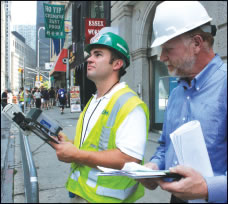BY Aline Reynolds
Personal DataRAM on. Check. Sound level meter working. Check. And so the day begins.
Air tester Tim Burns made his typical stops around the World Trade Center site on Monday, July 21 to check the airborne dust and sound levels. Thomas Kunkel, director of environmental compliance at the Lower Manhattan Construction Command Center, accompanies Burns to keep a close eye on things.
“You could actually see the dust in the beginning,” Kunkel said, when he and the air testers, contracted by L.M.C.C.C., would visit the sites in the mid-2000s. Puffs of black smoke from the construction site would billow up into the air.
Things are looking much better these days. Thanks to the air testers, there has been a nearly eight percent drop in particulate matter, or microscopic dust particles, in the area since 2004, according to the L.M.C.C.C, surpassing all national air quality standards.
“We’re not working against the construction guys, we’re working with them,” Burns explained.
He and Kunkel regularly chat with the safety and construction managers to advise them on the test results so they can act accordingly to contain the dust. L.M.C.C.C., which oversees around 200 construction projects below Canal Street, performs hundreds of sidewalk and idling checks per month at upwards of 60 sites. Seven of the sites are in or around the World Trade Center construction zone, which was a heavily polluted area only a few years ago.
Kunkel and Burns stopped at several different spots at each of the designated locations, spending 20 to 30 minutes per site. Before bringing out the machines, the testers sniff and observe the air quality. In scanning the area with his eyes, Kunkel concluded that the Fulton Street site is “clean and under control.”
Next, Burns tested the humidity. It was average that day, around 55 percent. Burns took note of this, since the moisture in the air can affect the air quality readings.
“We’ll take that into account when we analyze the data later,” he said.
He then measured for airborne dust. Burns and Kunkel were pleased to see that, without being told, the workers at the Fulton Street site slowly lowered the beam to minimize the spread of dust in the area. This likely contributed to the particulate matter reading at the site that day.
And, finally, Burns did the sound check. “It’s important that [the noise level] is below 85 decibels,” Burns said. “If it’s 90, you might not hear a police car.”
During his trip, Burns also polices idling trucks near the construction sites, who are only allowed to keep their engines running for three minutes at a time to minimize pollutants. As a result, vehicle emissions are also lower than the national air quality standards.
“It’s gratifying to be partaking in the environmental commitment and public safety of the site,” said Burns after completing his first assignment of the day. It’s an assignment that he’ll remember for the rest of his life, he added.
Burns and Kunkel then arrived at Liberty Street, where Kunkel gazed up and down the long corridor that connects the World Trade Center with the Financial District. “You can see the channel where the air passes through,” he noted, adding that the air looked and smelled clean and dust-free.
As Kunkel and Burns were returning to their route from Liberty, Kunkel was approached by a safety official who asked him how things were looking. “It’s looking good,” Kunkel replied.
“They don’t have to come off the site to see what’s going on — they feel obligated to do it,” he later said, noting the good rapport he has with the on-site officials.
Lowering pollution and noise from construction is all about teamwork, according to the duo. Construction managers have swiftly responded to the L.M.C.C.C. evaluations, performing around a dozen engineering controls to keep the dust from becoming airborne. They hose down the roadways and trucks daily to keep the dust from rising into the air. The site’s stationary cranes are all equipped with diesel particulate filters built to contain the soot. The construction zones are enclosed by fencing that wards off the wind, preventing the dust from spreading onto the streets. The fences also help insulate the sound, thereby reducing the noise level in the immediate area.
Kunkel and Burns returned to the offices with smiles on their faces. The day’s results looked good. The majority of sites had clean air, construction noise was kept at a minimum and there were puddles of water everywhere.
The only worrisome thing Kunkel saw at a stop on Liberty Street was a small pool of water forming on the outer edge of the site, an indication that the area hadn’t been dampened in a few hours — the larger the puddle, the better.
“It could probably use another hosing, based on the visual,” Kunkel said.
He planned on walking back down to the site later on that day to advise the construction workers.
Perhaps because of his work gear — a construction hat and the gray, suspicious-looking testing equipment — Burns has been approached by pedestrians who question what he’s doing.
“They’ve asked, ‘Are you with the feds?’” Burns said, chuckling.
No, he replies. And he resumes work.
































